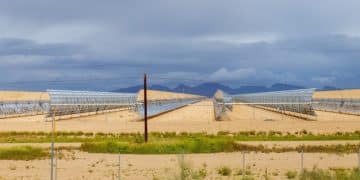Key Innovations Driving Down Solar Energy Storage Costs in the US

Key innovations driving down the cost of US solar energy storage systems include advancements in battery technology, economies of scale in manufacturing, streamlined installation processes, and supportive government policies that incentivize investment and deployment.
The United States is witnessing a significant shift towards renewable energy, with solar power taking center stage. However, the intermittent nature of sunlight poses a challenge, making energy storage crucial. Understanding what are the key innovations driving down the cost of US solar energy storage systems is pivotal for the continued growth and adoption of solar energy.
The Rise of Solar Energy Storage in the US
Solar energy has become increasingly competitive in the US energy market. However, the sun doesn’t shine 24/7, and that’s where energy storage comes in. Innovations in this field are essential for making solar a reliable and cost-effective energy source.
The integration of energy storage systems with solar installations is transforming the energy landscape, offering solutions to grid stability and energy security concerns. As costs decline, solar energy storage is becoming more accessible to homeowners, businesses, and utilities.
The Role of Government Incentives
Government policies play a crucial role in driving the adoption of solar energy and storage. Tax credits, rebates, and grants can significantly reduce the upfront costs of installing energy storage systems. These incentives encourage investment and accelerate the deployment of clean energy technologies.
Impact of Utility-Scale Projects
Large-scale solar energy storage projects are becoming more common, driven by the need for grid-scale energy storage. These projects benefit from economies of scale, allowing them to achieve lower costs per kilowatt-hour (kWh) of storage. Utility-scale projects also create opportunities for innovation and technology development.
- Investment Tax Credit (ITC): Federal tax credit for solar energy systems, including energy storage.
- State-Level Incentives: Various state programs offer additional rebates and tax credits.
- Grid Modernization Initiatives: Investments in grid infrastructure to support the integration of renewable energy.
In this section, we’ve explored the growing importance of solar energy storage in the US and discussed the factors driving its adoption, including government incentives and utility-scale projects. These developments are paving the way for a more sustainable and resilient energy system.

Advancements in Battery Technology
Battery technology is at the forefront of solar energy storage innovation. The development of more efficient, durable, and cost-effective batteries is essential for widespread adoption. Lithium-ion batteries have become the dominant technology, but other chemistries are also emerging.
The continuous improvement in battery energy density, cycle life, and safety is driving down the overall cost of energy storage. These advancements are making solar energy more reliable and competitive with traditional energy sources.
Lithium-Ion Batteries
Lithium-ion batteries have become the standard for energy storage due to their high energy density and relatively long lifespan. Ongoing research and development are focused on improving their performance and reducing costs. Innovations in electrode materials and cell design are contributing to these improvements.
Alternative Battery Chemistries
Beyond lithium-ion, other battery chemistries are gaining traction, including flow batteries, sodium-ion batteries, and solid-state batteries. These technologies offer unique advantages in terms of cost, safety, and environmental impact. They represent promising alternatives for specific applications.
- Increased Energy Density: Storing more energy in a smaller space.
- Extended Cycle Life: Withstanding more charge and discharge cycles.
- Enhanced Safety Features: Reducing the risk of thermal runaway and fire.
This section has highlighted the ongoing advancements in battery technology, focusing on lithium-ion batteries and alternative chemistries. These innovations are crucial for improving the performance and affordability of solar energy storage systems.
Economies of Scale in Manufacturing
Manufacturing plays a critical role in reducing the cost of solar energy storage systems. As production volumes increase, manufacturers can achieve economies of scale, which lead to lower unit costs. Streamlined manufacturing processes and automation also contribute to cost reductions.
With greater demand for energy storage, manufacturers are investing in new facilities and expanding existing ones. This increased capacity is driving down costs and making energy storage more accessible to a wider range of customers.
Mass Production Techniques
Mass production techniques, such as automated assembly lines and standardized components, enable manufacturers to produce batteries and other energy storage components at a lower cost. These techniques also improve product quality and consistency.
Supply Chain Optimization
Optimizing the supply chain is essential for reducing manufacturing costs. By sourcing materials from reliable suppliers and streamlining logistics, manufacturers can minimize waste and improve efficiency. Strategic partnerships with suppliers can also lead to cost savings.

- Reduced Material Costs: Negotiating lower prices for raw materials through bulk purchases.
- Lower Labor Costs: Automating manufacturing processes to reduce the need for manual labor.
- Improved Efficiency: Streamlining production processes to minimize waste and maximize output.
In this section, we’ve discussed the impact of economies of scale in manufacturing on the cost of solar energy storage systems. Mass production techniques and supply chain optimization are key drivers of cost reduction in this industry.
Streamlined Installation Processes
Installation costs can represent a significant portion of the total cost of a solar energy storage system. Streamlining the installation process is crucial for reducing these costs and making energy storage more affordable. Innovations in installation techniques and workforce training are contributing to these improvements.
Simplified installation procedures, such as plug-and-play systems and pre-assembled components, can significantly reduce the time and labor required for installation. Standardized installation practices also help to improve safety and reliability.
Modular Designs
Modular designs allow for easier and faster installation of energy storage systems. These systems consist of pre-fabricated modules that can be quickly assembled on-site. Modular designs also offer flexibility, allowing customers to customize their energy storage solutions to meet their specific needs.
Improved Training Programs
Investing in training programs for installers is essential for ensuring that energy storage systems are installed correctly and safely. These programs provide installers with the skills and knowledge they need to work with new technologies and follow best practices. Certified installers can also provide customers with greater confidence in the quality of their installations.
- Faster Installation Times: Reducing the time required to install energy storage systems.
- Lower Labor Costs: Minimizing the need for specialized labor and equipment.
- Improved Safety: Ensuring that energy storage systems are installed safely and reliably.
This section has highlighted the importance of streamlined installation processes in reducing the cost of solar energy storage systems. Modular designs and improved training programs are key factors contributing to these improvements.
Supportive Government Policies
Government policies play a vital role in promoting the adoption of solar energy storage systems. Incentives such as tax credits, rebates, and grants can significantly reduce the upfront costs of these systems. Regulations and standards also help to ensure the safety and reliability of energy storage technologies.
In addition to financial incentives, government policies can also support the development of energy storage infrastructure and promote research and development in this field. These policies can create a favorable environment for innovation and investment in the energy storage industry.
Federal Tax Credits
The federal Investment Tax Credit (ITC) provides a tax credit for solar energy systems, including energy storage. This credit can significantly reduce the cost of these systems, making them more accessible to homeowners and businesses. The ITC has been a major driver of solar energy growth in the US.
State Regulations and Standards
Many states have implemented regulations and standards to support the adoption of energy storage systems. These regulations can include requirements for grid interconnection, safety standards, and performance benchmarks. States are also developing policies to promote the use of energy storage for grid stabilization and resilience.
- Increased Adoption: Encouraging more homeowners and businesses to invest in energy storage.
- Grid Modernization: Supporting the integration of renewable energy into the grid.
- Economic Development: Creating jobs and stimulating investment in the energy storage industry.
This section has emphasized the role of government policies in supporting the adoption of solar energy storage systems. Federal tax credits and state regulations are key drivers of growth and innovation in this industry.
Emerging Business Models
Innovative business models are also contributing to the reduction in the cost of solar energy storage systems. These models include energy storage as a service (ESaaS), community solar plus storage, and virtual power plants (VPPs). These approaches offer new ways to finance and deploy energy storage technologies.
ESaaS allows customers to access energy storage without having to invest in the upfront costs of purchasing and installing a system. Community solar plus storage enables multiple customers to share the benefits of a single energy storage system. VPPs aggregate distributed energy resources, including solar and storage, to provide grid services.
Energy Storage as a Service (ESaaS)
ESaaS provides customers with access to energy storage systems without the need for a large upfront investment. Customers pay a monthly fee for the service, which includes installation, maintenance, and monitoring. This model can make energy storage more accessible to small businesses and homeowners.
Community Solar Plus Storage
Community solar plus storage allows multiple customers to share the benefits of a single solar and energy storage system. This approach can reduce costs by leveraging economies of scale and can make solar energy more accessible to renters and those who cannot install solar panels on their own roofs.
- Reduced Upfront Costs: Making energy storage more affordable for customers.
- Increased Flexibility: Offering a range of energy storage solutions to meet different needs.
- Improved Grid Services: Providing valuable grid services, such as frequency regulation and demand response.
In this section, we’ve explored emerging business models that are contributing to the reduction in the cost of solar energy storage systems. ESaaS and community solar plus storage are innovative approaches that are making energy storage more accessible and affordable.
| Key Point | Brief Description |
|---|---|
| ⚡ Battery Tech | Advancements in lithium-ion and alternative battery chemistries are boosting efficiency and lowering costs. |
| 🏭 Scale Economies | Increased production volumes and streamlined manufacturing processes reduce unit costs. |
| 🛠️ Installation | Modular designs and improved training programs streamline installation, cutting time and labor. |
| 政策 Gov. Policies | Tax credits and state regulations incentivize adoption and support infrastructure development. |
Frequently Asked Questions
▼
Solar energy storage offers benefits such as increased energy independence, reduced reliance on the grid, backup power during outages, and the ability to use solar energy at any time, even when the sun isn’t shining.
▼
The ITC provides a significant tax credit for solar energy systems, including storage, reducing the upfront cost and making it more financially attractive for homeowners and businesses to invest in solar plus storage.
▼
Besides lithium-ion, emerging battery technologies include flow batteries, sodium-ion batteries, and solid-state batteries. These technologies offer unique advantages regarding cost, safety, and environmental impact.
▼
Streamlined installation processes, such as using modular designs and improved training programs, reduce the time and labor required for installation, lowering the overall cost of solar energy storage systems.
▼
ESaaS is a business model where customers pay a monthly fee to access energy storage systems without the upfront investment. This includes installation, maintenance, and monitoring, making storage more affordable.
Conclusion
In conclusion, the declining cost of solar energy storage in the US is being driven by a combination of technological advancements, economies of scale, streamlined installation processes, supportive government policies, and innovative business models. These factors are making solar energy more reliable, affordable, and accessible, paving the way for a cleaner and more sustainable energy future.





